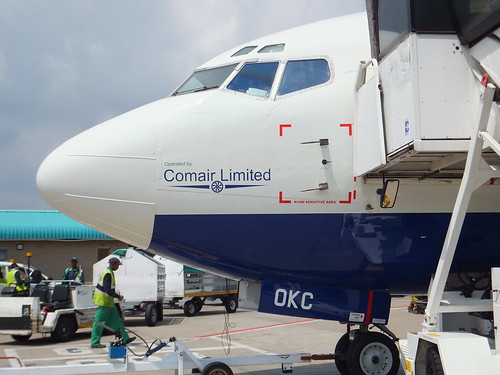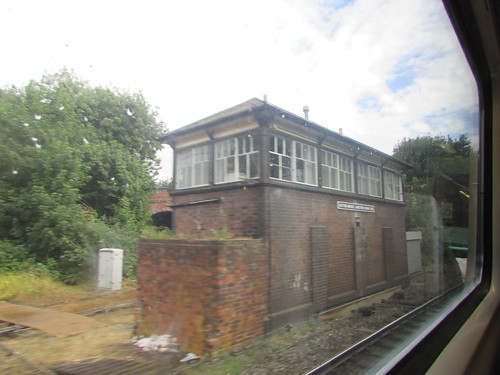skip to main |
skip to sidebar
 Comair 737 ZS-OKC on the ground at O. R. Tambo International Airport.
Comair 737 ZS-OKC on the ground at O. R. Tambo International Airport.
On my Safari Trip in February 2012 (described here, Boeing 737 ZS-OKC operated by Comair took me from O. R. Tambo to Livingstone. Whilst waiting to board, I noticed, marked in red on the side of the fuselage, the 'RVSM Sensitive Area'. I didn't know what 'RVSM' meant but it was not until I returned to the U.K. that I had an opportunity to research its significance (and it was almost another seven years before I wrote about it).
Although more modern techniques now exist, the basic method for determining an aircraft's altitude is by measuring barometric pressure with a 'pressure altimeter'. Increasing air traffic led to the introduction of a world-wide system of 'airways' with flying altitudes assigned to each aircraft to ensure safe vertical separation. Errors in measurement on the aircraft obviously potentially erode this separation. Continued growth in air traffic has led to improvements in pressure altimeters justifying an initial vertical separation of 2,000 feet between aircraft flying above Flight Level 290 ('Two,Nine,Zero') being reduced to 1,000 feet (as was already applied up to Flight Level 290). Of course, this requires suitably-tested equipment and the 'RVSM Sensitive Area' is kept pristine so that the air pressure sensed by the 'Pitot Tubes' feeding the pressure altimeter is not affected by turbulence.
Wikipedia has an article about this at Reduced vertical separation minima
.
The diagram below illustrating Non-RVSM and RVSM Flight Levels is from CSSI Inc:-

Non-RVSM and RVSM Flight Levels between FL290 and FL410.
CSSI Inc. also produced this sketch illustrating the effect of different errors on the altitude indicated to the pilot:-

Difference between Assigned and Actual Altitude.
There's more about altimeter setting on the excellent 'Skybrary' site here.
Of course, RVSM is just one feature of the amazing and complex Air Traffic Control system that world trade is dependent on.
Back in 2008, the post Work in progress stated my ambition regarding the backlog of draft blog posts to "Get 'em published, ready or not". How well did that work out? To my amazement, I have made 1,406 published posts at present, varying in length from the short to the quite long ("too long" do I hear you say?). But there are also 173 draft posts 'in the works', incomplete or awaiting further research.
The fact that I'm still working limits time available to write for the blog. I confess to still being a railway enthusiast (I think I prefer that term to 'railwayac' which I believe was used some time ago but unfortunately rhymes with 'maniac'). So that pastime consumes more of my available time (and is responsible for around half of the published posts). Finally, although my mobility is deteriorating with increasing age, my interest in travel is undiminished and any journey (even a modest one using the dreadful British railway system) supplies sufficient material for more unfinished posts.
The earlier 'Work in progress' post asked for the reader's indulgence regarding typographical and grammatical errors. Has that situation improved? Probably not. The editing software in 'Blogger' (which I still use) helpfully flags up spelling errors with a wiggly red underlining but, since it doesn't understand 'formatting directives', the editing screen is usually covered with highlighted formatting text, tending to hide the real errors. The other problem is that, just because a word is spelled correctly, it doesn't mean that's the word you intended. So, I will plod on, as best I can.
In the post An Apology, which appeared in 2009, I wrote about the perils of spelling place names, before digressing about L.M.S. signal box nameboards. For balance, below is a picture of a Great Western signal box nameboard. As I commented in the post here:-
The Great Western liked to dignify their signal boxes with a single, cast-iron name plate showing the name in full so I noticed the imposing length of the sign mounted on side facing the tracks reading 'SUTTON BRIDGE JUNCTION SIGNAL BOX'.

Shrewsbury area rail: Sutton Bridge Junction signal box, 28th July 2018.

Jan 'Blogging', 27th January 2019.
 Comair 737 ZS-OKC on the ground at O. R. Tambo International Airport.
Comair 737 ZS-OKC on the ground at O. R. Tambo International Airport.




